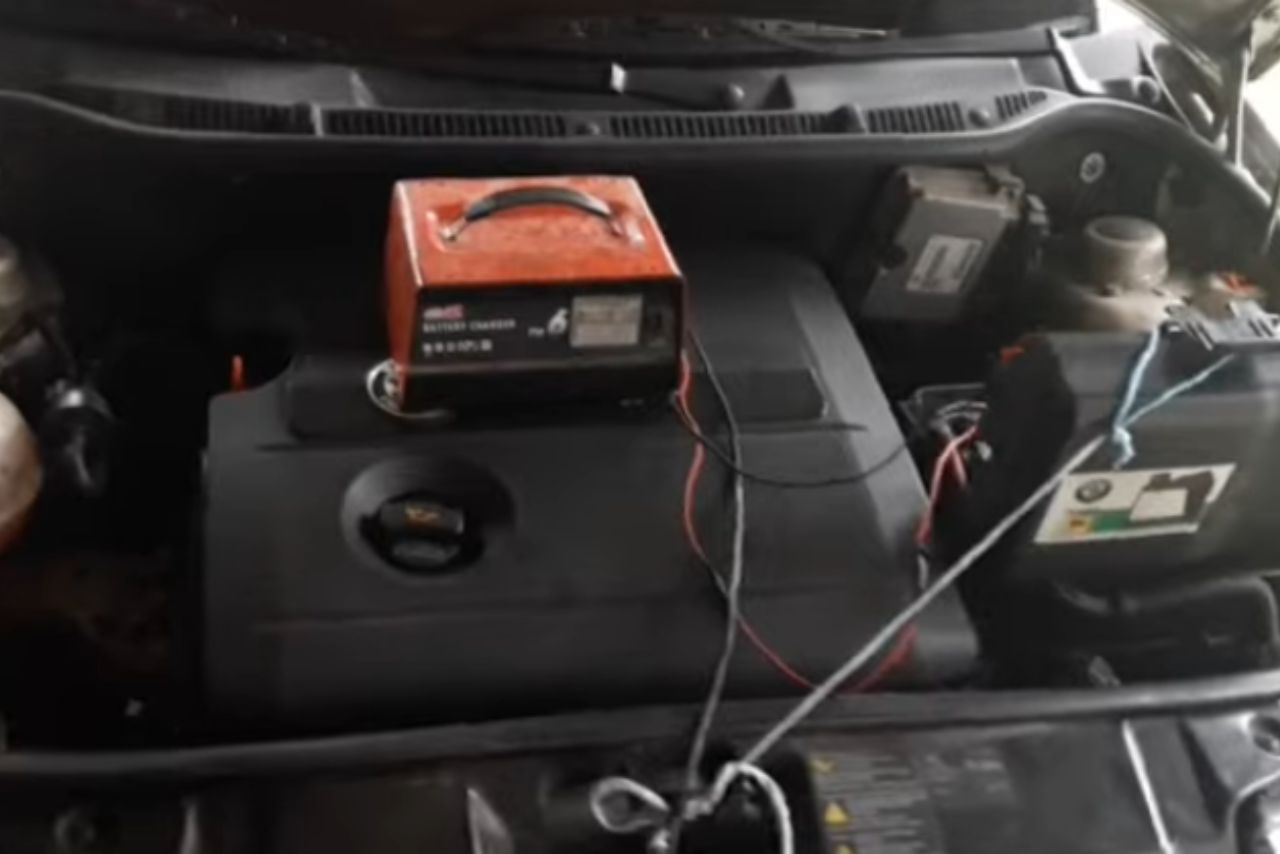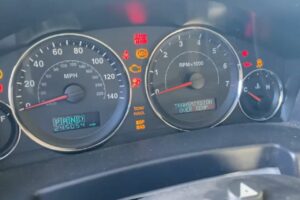Wondering How Long Should I Let My Car Idle to Charge the Battery? The answer is simple: around 25 minutes should do the trick. Leaving your car running for this amount of time allows the alternator to recharge the battery effectively, ensuring it has enough power to start the engine next time you need it.
Idling your car for too long can have some negative effects on both the environment and your vehicle. It can lead to unnecessary fuel consumption and increased emissions, not to mention the wear and tear on the engine.
That’s why it’s important to strike a balance between charging your battery and conserving resources.
So, the next time you need to charge your car battery, remember to let it idle for around 25 minutes. This will give your alternator enough time to do its job and ensure that your battery is ready to go when you need it.
Just be mindful of the impact excessive idling can have and try to find a balance that keeps both your battery and the environment happy.
Table of contents
Why Is It Necessary to Charge the Car Battery?
When it comes to keeping your car battery in good shape, charging it regularly is an essential part of vehicle maintenance. Let’s explore why charging the car battery is necessary:
- Prevents battery drain: Leaving your car unused for extended periods can lead to battery drain. Charging the battery ensures that it maintains a sufficient charge, preventing it from dying completely.
- Preserves battery lifespan: Regular charging helps extend the overall lifespan of your car battery. When a battery is consistently charged, it remains in better condition and is less prone to deterioration.
- Prevents sulfation: Sulfation is a common issue that occurs when lead-acid batteries, which most car batteries are, are left discharged for long periods. This can damage the battery and reduce its performance. Charging the battery regularly prevents sulfation buildup.
- Ensures reliable starts: A fully charged battery provides the necessary power to start your car smoothly and reliably. If your battery is not properly charged, you may experience difficulties starting your vehicle, especially during colder weather.
- Maintains electrical components: Your car’s electrical system relies on the battery to provide power. By keeping the battery charged, you ensure that all the electrical components, such as lights, radio, and power windows, function properly.
Remember, the exact charging time for your car battery may vary. However, a good rule of thumb is to let your car idle for around 25 minutes to allow the alternator to replenish the battery’s charge.
It’s important not to idle your car excessively, as it can waste fuel and contribute to unnecessary pollution.
| Reasons to Charge the Car Battery |
|---|
| Prevents battery drain |
| Preserves battery lifespan |
| Prevents sulfation |
| Ensures reliable starts |
| Maintains electrical components |
By charging your car battery regularly, you can ensure its longevity and avoid the inconvenience of a dead battery when you need your car the most.
Understanding the battery charging process:

When it comes to charging your car battery, it’s important to know how the process works to make sure you’re doing it right. Here are a few things to keep in mind:
- Battery chemistry: Car batteries typically use lead-acid chemistry, which requires a slow and steady charge to ensure longevity. Rapid charging can cause damage to the battery and reduce its overall lifespan.
- Alternator vs. charger: Your car’s alternator is responsible for charging the battery while the engine is running. However, it’s important to note that the alternator is not designed to fully recharge a deeply discharged battery. In such cases, an external charger might be necessary.
- Charging time: The time it takes to charge a car battery will depend on various factors, including the state of charge, battery capacity, and charging equipment. As a general guideline, it’s recommended to charge a battery for around 25 minutes or so to give it a decent boost. However, prolonged idling for the sole purpose of charging the battery is not advisable as it can waste fuel and potentially harm the environment.
Remember, periodically driving your car for extended periods is a better way to maintain and charge the battery than idling it for prolonged periods of time.
If you find yourself with a consistently discharged battery, it might be worth checking it for any underlying issues or seeking professional help.
| Aspect | Description |
|---|---|
| Battery chemistry | Lead-acid chemistry is commonly used in car batteries and requires a slow charge for best results. |
| Alternator vs. charger | The car’s alternator charges the battery while the engine is running, but an external charger may be needed for deeply discharged batteries. |
| Charging time | The time needed to charge a battery depends on factors like state of charge, capacity, and charging equipment. Charging for around 25 minutes can provide a good boost. |
By understanding the battery charging process, you can ensure that you’re taking the right steps to keep your car’s battery in good condition.
Myths About Idle Charging:
There are several myths surrounding the idea of letting your car idle to charge the battery. Let’s debunk them one by one:
Myth 1: Running the engine for a few minutes is enough to fully charge the battery.
Contrary to popular belief, idling your car for just a few minutes won’t fully charge the battery.
The charging process takes time, and a short idling session won’t provide enough power to replenish a significantly depleted battery.
Myth 2: Leaving the car engine idle overnight is beneficial for battery health.
Leaving your car engine running overnight is not only unnecessary but also wasteful. Continuous idling can put unnecessary strain on the engine and increase fuel consumption.
It’s better to use a battery charger or take your car for a longer drive to charge the battery properly.
Myth 3: Idling actually harms the battery life.
While idling for short periods won’t harm the battery, extended periods of idling can have negative effects on its overall health.
Consistently relying on idling for battery charging instead of taking the car for a longer drive may prevent the battery from reaching its full potential and contribute to premature degradation.
Remember, idling your car should be done sparingly and primarily for maintenance purposes like running the air conditioning or heating systems.
For charging the battery, taking the car for a drive is a much more effective and efficient method.
| Myth 1 | Debunked |
| Myth 2 | Debunked |
| Myth 3 | Debunked |
Factors Affecting Idle Charging Time:
When it comes to charging your car battery by letting your car idle, the time it takes can vary depending on several factors.
Understanding these factors can help you better determine how long you should let your car idle to effectively charge the battery. Let’s take a look at some key considerations:
- Battery Capacity: The capacity of your car’s battery plays a crucial role in determining the idle charging time. A larger battery with a higher capacity will generally take longer to charge compared to a smaller battery. However, keep in mind that the battery’s age and overall health also influence the charging time.
- Battery Charge Level: If your battery is completely drained, it will require more time to recharge compared to a partially depleted battery. A deeply discharged battery may require several hours of idle time to reach an adequate charge level.
- Alternator Output: The alternator is responsible for generating electricity and charging the battery while the engine is running. Different vehicles have alternators with varying output capacities. A higher-output alternator can charge your battery more quickly, resulting in a shorter idle charging time.
- Driving Conditions: The driving conditions and usage patterns can affect the idle charging time. If you frequently drive short distances or use power-consuming accessories (such as air conditioning or high-powered audio systems), your battery may not fully recharge during idle time. In such cases, it may be necessary to drive for an extended period to allow the alternator to provide sufficient charge.
- Environmental Factors: Extreme temperatures, both hot and cold, can affect battery performance and the rate of charge. In cold weather, the battery has reduced capacity, requiring more time to charge. Hot weather can accelerate the battery’s self-discharge rate, which may also affect idle charging time.
Consider these factors to get a rough idea of how long you should let your car idle to charge the battery effectively. However, it’s essential to note that idling alone may not always be the most efficient method of charging your battery.
You may want to consider using a battery charger or simply driving your car for a longer period to ensure a more complete recharge.
| Factors Affecting Idle Charging Time |
|---|
| Battery Capacity |
| Battery Charge Level |
| Alternator Output |
| Driving Conditions |
| Environmental Factors |
Remember, it’s always a good idea to consult your vehicle’s manual or seek professional advice if you are uncertain about charging your car’s battery properly.
How Long Should You Let Your Car Idle to Charge the Battery?
When it comes to charging your car battery by idling the engine, there’s no one-size-fits-all answer.
The ideal duration depends on various factors, such as the age and condition of your battery, the type of vehicle you have, and the climate you’re in. While some general guidelines can help, it’s best to consider your unique situation.
Here are a few things to keep in mind:
Remember, idling for extended periods can waste fuel and contribute to air pollution.
It’s generally recommended to limit idling and consider alternative methods for charging the battery, such as using a battery charger or going for a longer drive.
Below is a table summarizing the key factors and their impact on the charging time:
| Factors to Consider | Impact on Charging Time |
|---|---|
| Battery age and condition | Varies |
| Vehicle type | Varies |
| Climate | Colder weather: longer |
| Driving habits | Short trips: longer |
By taking these factors into account and understanding your specific circumstances, you can determine how long you should let your car idle to charge the battery effectively.
Remember, if you’re unsure, consulting a mechanic or referring to your vehicle’s manual can provide more accurate guidance.
Alternatives to idle charging:
There are other ways to charge your car battery without leaving your engine running for extended periods. Here are some alternatives to idle charging:
- Using a battery charger: Investing in a battery charger is a reliable and efficient method to charge your car battery. These devices can be plugged into a power outlet and provide a controlled current to charge the battery. It’s important to follow the manufacturer’s instructions for the specific charger you have.
- Taking extended drives: Taking your car on longer trips allows the alternator to charge the battery while you drive. The more you drive, the longer the alternator has to replenish the battery’s charge. However, this method may not be feasible for everyone, especially if you have a busy schedule.
- Jump-starting: If your battery is completely dead, you can use jumper cables and a second vehicle to jump-start your car. Connect the positive and negative terminals of both batteries properly, and allow the working vehicle to run for a few minutes to transfer some charge to your battery. Remember, jump-starting is only a temporary solution and doesn’t provide a full charge.
- Solar chargers: Solar chargers harness the power of the sun to trickle charge your car battery. These portable devices typically include solar panels that need to be placed in direct sunlight. While solar chargers may not provide a quick charge, they can help maintain the battery’s charge over time.
- Battery tender: Battery tenders, also known as smart chargers, are designed to maintain the charge of your car battery by delivering a low current over an extended period. These devices are particularly useful for long periods of inactivity, such as during winter storage.
Remember, it’s always important to consult your car’s manual and follow the manufacturer’s recommendations when it comes to charging your specific battery.
Each car may have different requirements, so it’s essential to ensure you’re using the appropriate charging method.
| Alternative Charging Method | Pros | Cons |
|---|---|---|
| Battery Charger | Reliable and efficient charging | Requires purchasing a charger |
| Extended Drives | Charges battery while driving | Not suitable for all individuals |
| Jump-starting | Quick fix for dead battery | Temporary solution that doesn’t provide a full charge |
| Solar Chargers | Uses sustainable energy source | Slow charging compared to other methods |
| Battery Tender | Maintains battery charge over extended periods | Not effective for quickly charging a fully depleted battery |
By considering these alternatives, you can find a charging method that suits your needs and ensures your car battery remains in good condition.
The Impact of Idle Charging on the Environment:
As convenient as it may seem to let your car idle to charge the battery, it’s important to consider the impact it has on the environment. Here are a few key points to keep in mind:
Pollution from Exhaust Emissions:
Fuel Consumption and Resource Depletion:
Noise Pollution:
- While not directly related to the environment, idling cars also contribute to noise pollution.
- Excessive noise from idling engines can disturb nearby residents, wildlife, and even disrupt the peace and tranquility we desire in our surroundings.
Considering the environmental impact of idle charging is essential. Although it may seem convenient in the short term, there are more sustainable alternatives for charging your car’s battery.
Embracing modern charging methods, such as using dedicated plug-in chargers or opting for hybrid or electric vehicles, can significantly reduce your carbon footprint and help protect the environment.
| Statistics for Idle Charging |
|---|
| Fuel Efficiency During Idle Charging: Decreases |
| Carbon Dioxide (CO2) Emissions: Increases |
| Nitrogen Oxide (NOx) Emissions: Increases |
| Particulate Matter Emissions: Increases |
| Fuel Consumption during Idle Charging: Varies |
| Noise Pollution: Increases |
By being aware of the environmental consequences of idle charging, we can make more informed decisions that benefit both our cars and the planet. Remember, every small action counts when it comes to preserving our environment for future generations.
Precautions for idle charging:
When it comes to idle charging your car battery, there are a few precautions you should keep in mind to ensure optimal and safe charging. Here are some key points to consider:
- Avoid excessive idling: While it’s important to charge your battery, aim to strike a balance and avoid excessive idling. Prolonged idling can lead to issues such as fuel wastage, increased emissions, and potential damage to engine components. It’s generally recommended to limit idle charging to a reasonable duration.
- Ensure proper ventilation: When idling to charge your battery, ensure that the area is well-ventilated. Carbon monoxide, a colorless and odorless gas emitted by your car’s exhaust, can be harmful if inhaled in enclosed spaces. For your safety, keep windows open or park your vehicle in a well-ventilated area.
- Monitor engine temperature: Keep an eye on your car’s engine temperature while idle charging. Extended periods of idling can cause the engine to overheat, especially in warm weather or if your vehicle has an older cooling system. If you notice the temperature gauge rising above normal levels, it’s advisable to turn off the engine and let it cool down before attempting to charge the battery further.
- Consider using a battery charger: Instead of relying solely on idle charging, you may want to consider using a dedicated battery charger. These chargers are designed to provide a controlled and efficient charge to your battery without the need for idling your car. A battery charger can be a convenient and safer alternative, especially if you frequently find yourself needing to charge your battery.
Remember, while idle charging can be helpful in certain situations, it’s not a long-term solution for maintaining a healthy battery.
Regular driving and highway speeds are the most effective ways to keep your battery charged.
Use idle charging as a temporary solution and consider having your battery and charging system inspected by a professional if you experience repeated battery drain issues.
| Precaution | Importance |
|---|---|
| Avoid excessive idling | High |
| Ensure proper ventilation | Medium |
| Monitor engine temperature | Medium |
| Consider using a battery charger as an alternative | Low |
How to Maintain a Healthy Car Battery?
Taking good care of your car battery is essential for ensuring optimal performance and longevity. Here are some simple tips to help you maintain a healthy car battery:
1. Regularly Inspect and Clean the Battery
- Check the battery regularly for signs of corrosion, such as white or blue powdery deposits. If you notice any corrosion, clean it using a mixture of baking soda and water.
- Ensure that the battery terminals are clean and free from any buildup. Use a wire brush to gently scrub away any dirt or debris.
2. Avoid Overworking the Battery
- Limit the use of electric devices when the engine is not running to avoid draining the battery unnecessarily.
- If possible, park your car in a shaded area during hot weather. Extreme heat can cause the battery to deteriorate faster.
3. Drive Your Car Regularly
- Regularly driving your car helps keep the battery charged. If you leave your car parked for an extended period, consider taking it for a short drive every week to prevent the battery from losing its charge.
- Take longer drives occasionally to fully charge the battery and maintain its health.
4. Monitor Battery Fluid Levels
- Some car batteries require regular maintenance, including checking and topping up the electrolyte levels. Refer to your car’s manual for instructions on how to do this. Ensure you follow proper safety procedures if handling battery electrolyte.
5. Prevent Parasitic Battery Drain
- Make sure all lights, including interior dome lights, are turned off when you leave the car.
- Check that all accessories, such as phone chargers, are unplugged when not in use, as they can draw power from the battery even when the car is off.
Remember, proper care and maintenance can extend the lifespan of your car battery, saving you time and money in the long run.
Conclusion and final thoughts 
When it comes to charging your car battery, letting your car idle for around 25 minutes can be beneficial.
However, it’s important to keep in mind that this is just a general guideline and may vary depending on various factors such as the age of your battery, the type of vehicle you drive, and the prevailing weather conditions.
Here are a few key points to remember:
- Avoid excessive idling: While idling for a short period can help charge your battery, excessive idling can waste fuel and contribute to air pollution. So, it’s always best to strike a balance and avoid unnecessarily long idle times.
- Consider other charging methods: Instead of relying solely on idling, you can opt for alternative charging methods like jump-starting your car using another vehicle or using a dedicated battery charger. These methods can provide a more efficient and controlled charge to your battery.
- Conserve battery power: To prevent draining your battery in the first place, make sure to turn off all electrical accessories, such as the lights, radio, and air conditioning, when the engine is not running. This will help preserve your battery’s charge and prolong its lifespan.
Latest Posts:
- Can WD-40 Remove Scratches on Cars? (Hint: Yes, but…)
- Can You Use a Drill to Polish Your Car? (We Tried it Out!)
- Should You Cover Car Scratches With Stickers? (REVEALED!)
- Buick Service Stabilitrak: (Causes & 100% Guaranteed Fix!)
- Common Holden Trax Problems (Causes & 100% Proven Fixes!)
- Jeep Commander Transmission Over Temp: (Guaranteed Fix!)











Leave a Reply